Do you have a question about the Bender ISOMETER iso1685DP-425 and is the answer not in the manual?
Explains manual usage and symbols for important instructions and information.
Provides contact information for end customer support, repair, and calibration services.
Information on finding dates for training courses and workshops.
Mentions Bender sale and delivery conditions, including software clauses.
Specifies conditions for storing the device to ensure its protection and functionality.
Details exclusions for warranty and liability claims due to improper use or non-compliance.
Guidelines for disposing of the device according to WEEE and RoHS directives.
General advice on reading the manual before operation and keeping it accessible.
States that only qualified personnel are permitted to work on electrical installations.
Safety notes specific to installing the device in control cabinets and IT systems.
Defines the device's purpose for monitoring insulation resistance in IT systems.
Lists key features of the ISOMETER® for AC/DC IT systems, including measurement capabilities.
Describes the ISOMETER®'s role in insulation monitoring and fault location.
Explains how insulation monitoring and fault location functions operate.
Provides detailed physical dimensions of the device in millimeters.
Details the device's electrical connections and their corresponding functions.
Describes the device's display screen and control buttons.
Explains how to navigate menus and adjust settings using the device buttons.
Instructions for physically mounting the device, including screw types and placement.
Covers connection requirements and step-by-step connection procedures.
Specific wiring diagram for connecting to a 3AC system with EDS440 and IOM441.
Step-by-step guide for commissioning the insulation fault monitoring function.
Guide for commissioning the insulation fault location feature.
Detailed steps for the initial setup and configuration of the device.
Steps for recommissioning the device if it has been previously operated.
Steps to put an EDS into operation after ISOMETER® commissioning.
Describes the normal operating display showing OK status and measured resistance.
Explains how active faults are indicated on the display and LEDs.
How inactive faults (past events) are indicated on the display.
Procedures for acknowledging and resetting fault messages.
Describes the isoGraph feature for viewing insulation resistance over time.
Details how alarm messages and device errors are stored with timestamps.
Explains display indications during active insulation fault location.
Provides an overview of the device's menu hierarchy and available settings.
Detailed menu structure for EDS settings specific to isoxx1685DP devices.
Configuration options for alarms, profiles, device functions, and EDS.
Configuration of alarm limits for alarm 1 and alarm 2.
Setting limit values for alarm 1 and alarm 2 for insulation monitoring.
Configuration of alarm behaviour at device start.
Selecting system profiles for optimal measurement and quality.
Activating or deactivating the insulation resistance measurement function.
Continuous monitoring of energised and de-energised system couplings.
Setting power frequency limits for specific device models.
Activating/deactivating single-pole operation for isoHV1685D.
Configuration of the device's digital inputs, including mode and timing.
Configuration of the device's alarm relays and buzzer.
Parameters for configuring Relay 1, including TEST and Relay mode.
Parameters for configuring Relay 2, referencing Relay 1 settings.
Notes that Relay 3 is not in the device menu and has fixed settings.
Parameters for configuring the device's buzzer, including TEST function.
Assigning functions to outputs, e.g., alarms, connection faults, or device errors.
Settings for the EDS feature for insulation fault location.
General overview of EDS settings for insulation fault location.
Selecting the mode for insulation fault location (Manual, Auto, 1 Cycle).
Setting the maximum locating current for the EDS.
Starting a search for EDS measuring channels.
Procedures for activating measuring channels before configuration.
Adjusting settings for multiple EDS or channels simultaneously.
Configuring individual measuring channels of the EDS.
Setting the type of current transformer used.
Enabling or disabling monitoring of current transformers.
Setting the response value for the main alarm in insulation fault location.
Setting the response value for residual current measurement.
Menu for configuring the outputs of the EDS.
Selecting and configuring common relays for the EDS.
Assigning functions to outputs, e.g., alarms, connection faults, or device errors.
Selecting channel relays for configuration.
Selecting buzzers to be configured for various events.
Setting functions for the buzzer, e.g., insulation fault or device error signals.
Configuring digital outputs of the EDS.
Configuring digital inputs of the EDS.
General device settings for the EDS, like System type.
Adjusting the EDS to the IT system type (DC, AC, 3AC).
Configuring the power frequency of the IT system to be monitored.
Synchronizing locating current pulses with EDS via BMS bus.
Storing faults that only occur temporarily.
Configuring individual channels of the EDS.
Assigning names to channels for easier identification.
Menu for configuring EDS outputs.
Performing manual tests and resetting alarm messages.
Displaying faults detected by the ISOMETER® and resetting memory.
Basic device settings like language and clock.
Choosing the display language for the ISOMETER®.
Setting the date and time format for the device.
Setting parameters for connecting other devices via BMS or Modbus.
Configuring BMS address settings.
Configuring Modbus RTU address, baud rate, parity, and stop bits.
Adjusting the display brightness of the ISOMETER®.
Setting a password to protect device parameters from unauthorized adjustment.
Starting the ISOMETER®'s commissioning wizard again.
Option to restore factory default settings.
Service menu accessible only by Bender service staff.
Viewing device information like name, software version, and settings.
Notes that communication with EDS devices is only possible via BMS protocol.
Details the RS-485 interface and BMS protocol for data transfer.
Explains the physical topology and connection of the RS-485 network.
Explains the importance and method of terminating the RS-485 network.
Examples of correct and incorrect RS-485 network arrangements.
Recommended cable and bus node limits for the RS-485 network.
Details the parameters and operation of the BMS protocol.
Describes the role and function of the BMS master device.
Steps for commissioning an RS-485 network using the BMS protocol.
Importance of correct address setting and network termination for bus errors.
How to set the BMS address for the ISOMETER® (master or slave).
Description of alarm and operating messages transmitted via the BMS bus.
Lists specific alarm messages, their channels, descriptions, actions, and LED indicators.
How to reset error messages via the device menu or BMS bus.
A list of BMS error codes, components, errors, and recommended actions.
Overview of the Modbus protocol for data transfer and its register addresses.
Introduction to selective insulation fault location using ISOMETER® and EDS.
Information on connecting EDS and setting locating current and EDS mode.
How active insulation fault location is shown on the ISOMETER® display.
Methods for starting and stopping the insulation fault location feature.
Details different device profiles and their suitability for various systems.
Description of the "Power circuits" profile for standard IT systems.
Details the "High capacitance" profile for systems with high leakage.
Description of the "Inverter > 10 Hz" profile for dynamic frequency control.
Description of the "Inverter < 10 Hz" profile for low-frequency control.
Details the "Fast 2000 µF" profile for photovoltaic systems with high leakage.
Diagrams showing the relationship between insulation resistance and leakage capacitance.
Lists the default factory settings for various parameters and functions.
Insulation coordination data according to IEC standards.
Specifies the nominal system voltage ranges for different device models.
Technical details of the measuring circuit parameters.
Lists response values for alarms and measurement profiles.
Technical details on time response characteristics.
Technical details for the EDS measuring circuit.
Technical specifications for the device display.
Technical specifications for device LEDs.
Technical specifications for digital inputs.
Technical specifications for the serial interface (RS-485, BMS, Modbus).
Technical details for mains connection, including terminals and conductor sizes.
Details on switching elements like relays and their operating principles.
Climatic and mechanical condition classifications and ambient temperatures.
Other technical specifications like operating mode, weight, and protection degrees.
Lists the standards and certifications the devices comply with.
Lists device types, response values, voltage, and article numbers.
Explains manual usage and symbols for important instructions and information.
Provides contact information for end customer support, repair, and calibration services.
Information on finding dates for training courses and workshops.
Mentions Bender sale and delivery conditions, including software clauses.
Specifies conditions for storing the device to ensure its protection and functionality.
Details exclusions for warranty and liability claims due to improper use or non-compliance.
Guidelines for disposing of the device according to WEEE and RoHS directives.
General advice on reading the manual before operation and keeping it accessible.
States that only qualified personnel are permitted to work on electrical installations.
Safety notes specific to installing the device in control cabinets and IT systems.
Defines the device's purpose for monitoring insulation resistance in IT systems.
Lists key features of the ISOMETER® for AC/DC IT systems, including measurement capabilities.
Describes the ISOMETER®'s role in insulation monitoring and fault location.
Explains how insulation monitoring and fault location functions operate.
Provides detailed physical dimensions of the device in millimeters.
Details the device's electrical connections and their corresponding functions.
Describes the device's display screen and control buttons.
Explains how to navigate menus and adjust settings using the device buttons.
Instructions for physically mounting the device, including screw types and placement.
Covers connection requirements and step-by-step connection procedures.
Specific wiring diagram for connecting to a 3AC system with EDS440 and IOM441.
Step-by-step guide for commissioning the insulation fault monitoring function.
Guide for commissioning the insulation fault location feature.
Detailed steps for the initial setup and configuration of the device.
Steps for recommissioning the device if it has been previously operated.
Steps to put an EDS into operation after ISOMETER® commissioning.
Describes the normal operating display showing OK status and measured resistance.
Explains how active faults are indicated on the display and LEDs.
How inactive faults (past events) are indicated on the display.
Procedures for acknowledging and resetting fault messages.
Describes the isoGraph feature for viewing insulation resistance over time.
Details how alarm messages and device errors are stored with timestamps.
Explains display indications during active insulation fault location.
Provides an overview of the device's menu hierarchy and available settings.
Detailed menu structure for EDS settings specific to isoxx1685DP devices.
Configuration options for alarms, profiles, device functions, and EDS.
Configuration of alarm limits for alarm 1 and alarm 2.
Setting limit values for alarm 1 and alarm 2 for insulation monitoring.
Configuration of alarm behaviour at device start.
Selecting system profiles for optimal measurement and quality.
Activating or deactivating the insulation resistance measurement function.
Continuous monitoring of energised and de-energised system couplings.
Setting power frequency limits for specific device models.
Activating/deactivating single-pole operation for isoHV1685D.
Configuration of the device's digital inputs, including mode and timing.
Configuration of the device's alarm relays and buzzer.
Parameters for configuring Relay 1, including TEST and Relay mode.
Parameters for configuring Relay 2, referencing Relay 1 settings.
Notes that Relay 3 is not in the device menu and has fixed settings.
Parameters for configuring the device's buzzer, including TEST function.
Assigning functions to outputs, e.g., alarms, connection faults, or device errors.
Settings for the EDS feature for insulation fault location.
General overview of EDS settings for insulation fault location.
Selecting the mode for insulation fault location (Manual, Auto, 1 Cycle).
Setting the maximum locating current for the EDS.
Starting a search for EDS measuring channels.
Procedures for activating measuring channels before configuration.
Adjusting settings for multiple EDS or channels simultaneously.
Configuring individual measuring channels of the EDS.
Setting the type of current transformer used.
Enabling or disabling monitoring of current transformers.
Setting the response value for the main alarm in insulation fault location.
Setting the response value for residual current measurement.
Menu for configuring the outputs of the EDS.
Selecting and configuring common relays for the EDS.
Assigning functions to outputs, e.g., alarms, connection faults, or device errors.
Selecting channel relays for configuration.
Selecting buzzers to be configured for various events.
Setting functions for the buzzer, e.g., insulation fault or device error signals.
Configuring digital outputs of the EDS.
Configuring digital inputs of the EDS.
General device settings for the EDS, like System type.
Adjusting the EDS to the IT system type (DC, AC, 3AC).
Configuring the power frequency of the IT system to be monitored.
Synchronizing locating current pulses with EDS via BMS bus.
Storing faults that only occur temporarily.
Configuring individual channels of the EDS.
Assigning names to channels for easier identification.
Menu for configuring EDS outputs.
Performing manual tests and resetting alarm messages.
Displaying faults detected by the ISOMETER® and resetting memory.
Basic device settings like language and clock.
Choosing the display language for the ISOMETER®.
Setting the date and time format for the device.
Setting parameters for connecting other devices via BMS or Modbus.
Configuring BMS address settings.
Configuring Modbus RTU address, baud rate, parity, and stop bits.
Adjusting the display brightness of the ISOMETER®.
Setting a password to protect device parameters from unauthorized adjustment.
Starting the ISOMETER®'s commissioning wizard again.
Option to restore factory default settings.
Service menu accessible only by Bender service staff.
Viewing device information like name, software version, and settings.
Notes that communication with EDS devices is only possible via BMS protocol.
Details the RS-485 interface and BMS protocol for data transfer.
Explains the physical topology and connection of the RS-485 network.
Explains the importance and method of terminating the RS-485 network.
Examples of correct and incorrect RS-485 network arrangements.
Recommended cable and bus node limits for the RS-485 network.
Details the parameters and operation of the BMS protocol.
Describes the role and function of the BMS master device.
Steps for commissioning an RS-485 network using the BMS protocol.
Importance of correct address setting and network termination for bus errors.
How to set the BMS address for the ISOMETER® (master or slave).
Description of alarm and operating messages transmitted via the BMS bus.
Lists specific alarm messages, their channels, descriptions, actions, and LED indicators.
How to reset error messages via the device menu or BMS bus.
A list of BMS error codes, components, errors, and recommended actions.
Overview of the Modbus protocol for data transfer and its register addresses.
Introduction to selective insulation fault location using ISOMETER® and EDS.
Information on connecting EDS and setting locating current and EDS mode.
How active insulation fault location is shown on the ISOMETER® display.
Methods for starting and stopping the insulation fault location feature.
Details different device profiles and their suitability for various systems.
Description of the "Power circuits" profile for standard IT systems.
Details the "High capacitance" profile for systems with high leakage.
Description of the "Inverter > 10 Hz" profile for dynamic frequency control.
Description of the "Inverter < 10 Hz" profile for low-frequency control.
Details the "Fast 2000 µF" profile for photovoltaic systems with high leakage.
Diagrams showing the relationship between insulation resistance and leakage capacitance.
Lists the default factory settings for various parameters and functions.
Insulation coordination data according to IEC standards.
Specifies the nominal system voltage ranges for different device models.
Technical details of the measuring circuit parameters.
Lists response values for alarms and measurement profiles.
Technical details on time response characteristics.
Technical details for the EDS measuring circuit.
Technical specifications for the device display.
Technical specifications for device LEDs.
Technical specifications for digital inputs.
Technical specifications for the serial interface (RS-485, BMS, Modbus).
Technical details for mains connection, including terminals and conductor sizes.
Details on switching elements like relays and their operating principles.
Climatic and mechanical condition classifications and ambient temperatures.
Other technical specifications like operating mode, weight, and protection degrees.
Lists the standards and certifications the devices comply with.
Lists device types, response values, voltage, and article numbers.
| Brand | Bender |
|---|---|
| Model | ISOMETER iso1685DP-425 |
| Category | Measuring Instruments |
| Language | English |
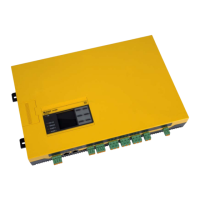

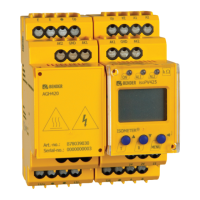
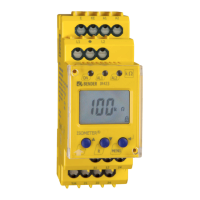

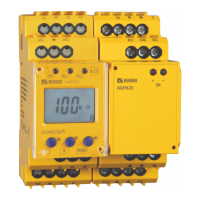

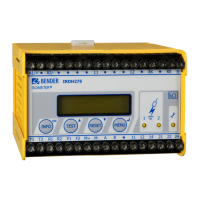

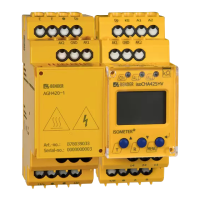
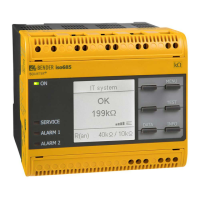
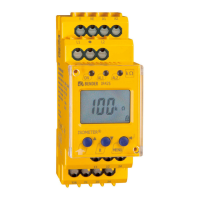
